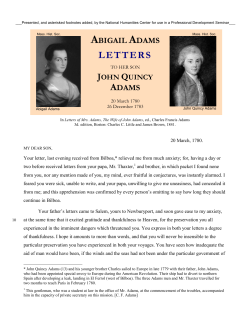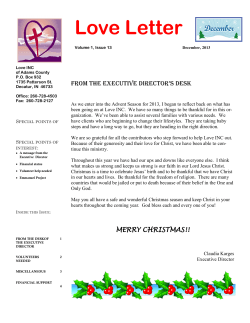
Adams Technologies AdamsTech As Seen In
Adams Technologies s In phic n a See l Gr 2 s A ita 01 ig er 2 D n & ctob O Sig AdamsTech began selling SDS automated bending machines in 1997. Since then, they have sold over 600 machines in North America and South America and their associated islands. Globally, over 2,000 SDS bending machines are currently in operation. AdamsTech’s years of experience and installed base ensure their customers the best machines and the best service in the world. The quality, versatility, and flexibility built into the equipment sets SDS products apart from the competition. According to Mike Adams, President of AdamsTech in Boulder, Colorado, the machines can produce all types of fabricated letters, not just large, front lit channel letters. “Most of the other machines available can make large block letters, but they stumble when they have to make small or intricate letters. Our machines can make brass, bronze, stainless, and galvanized letters. Even dimensional letters are easy to make with our flagship unit, Super ChannelBender®. Super ChannelBender can also process LetterBox™, our proprietary extruded aluminum return material for the production of trimless channel letters. This revolutionary new technique is the future of fabricated letters.” Value-Added Products Adams has strong opinions about the trend toward commoditization of channel letters in the sign industry. “In the minds of many sign buyers, channel letters have become a commodity product,” he says, “Those who go with the lowest competitive bid should consider the consequences. Commodity pricing results in the decline of overall service and quality, and stifles innovation.” What is the solution to the problem of commodity pricing? According to Adams, value-added products. “When selling to discriminating customers, sign makers who innovate have a competitive edge over those who only provide typical products. There will always be those who choose to purchase average signage and there will always be those who choose to purchase exceptional signage. It is the responsibility of those manufacturers to convey to their customers the differences inherent in those products. Even though it’s usually more expensive, when buyers see the benefits, they often decide to purchase the value-added signage. One thing is clear: if you want to move away from commodity pricing, you must move away from the traditional production of channel letters and create new types of signage that solve problems and provide unique solutions for your customers.” LetterBox Returns What constitutes exceptional fabricated letters and logos, and how do they differ from ordinary channel letters? According to Adams, “One answer is broaching, a machining process that creates the sharp bends and small distances between bends necessary for custom letters and logos. Another answer is trimless channel letters. Super ChannelBender can process LetterBox, our new extruded aluminum return material that uses our EasyClip™ assembly method. Letters produced using this method are made without trim cap. Innovations like these allow sign makers to better compete in the market.” “LetterBox returns allow you to produce signs that cannot be produced efficiently any other way,” Adams continues, “The extruded material enables you to produce many variations of fabricated letters: frontlight, edgelight, halo, frontlight/edgelight, frontlight/halo, halo/edgelight, and dimensional letters. All these variations are done without the need for rivets, staples, clinching, welding, or even trim cap. That’s right. Trimless channel letters!” Service and Support When making a decision to purchase an automated bending system, sign making companies should consider the features of the equipment, its reliability, the reliability of the company manufacturing and selling it, and the quality of their service and support. Harmon Sign of Toledo, Ohio, and Detroit, Michigan, has been evaluating channel letter automation equipment since the first primitive semi-automatic machines appeared on the market. They recently made the decision to invest in the SDS Super ChannelBender from AdamsTech. According to Jeff Kasper, President of Harmon Sign, “This was the first machine that met our requirements. The decision was based on several factors. We judged the equipment more versatile and flexible than other options. The machine can produce more than just big block letters. The most critical factor was the price-value relationship. We felt that we could justify the investment, and it would yield a return on our investment.” Jeff Morrow, Harmon Sign Plant Manager, adds, “We are happy with the equipment. It is in daily operation, and has been reliable. It has enabled us to significantly reduce our labor costs.” Return on Investment James Cross, Product Manager for the ChannelBender series, points out, “Return on investment is the main concern for most sign makers. Production and profitability are the result of a few key factors: speed, efficiency, and labor cost. Based on real world tests in a production environment, our SDS Super ChannelBender is 15 to 30 percent faster than our nearest competitor’s machine. That figure has nothing to do with feed rates. The real tests are how fast and how precisely a machine can actually fabricate the letters.” The versatility of an automated bending system can translate into a much faster return on investment, too. For example, when a sign maker gets a request for fabricated dimensional or architectural letters and logos, if the requirements of the design can be met with stock letters in standard fonts, they simply order the letters from a wholesale supplier. But if the design calls for a custom logo or nonstandard fonts, having someone else manufacture these can be costly and take time. Custom letters manufactured in-house offer the ability to break free from the downward spiral of commodity pricing. Most customers with these requirements are willing to pay a fair price for the value The ChannelBender Series received. Of course, to achieve the sharp bends and small distances between bends necessary for these types of letters, broaching is required. Many of these fabricated dimensional letters, whether stainless, brass, bronze, copper, anodized aluminum, or painted metal, are made using very shallow returns. One inch deep returns are common. Adams points out, “When choosing automation equipment, remember that the more versatile the equipment, the faster the return on investment.” Innovation Eco ChannelBender Easy ChannelBender Versatility was also a factor in the decision to purchase a Super ChannelBender at Tyson Signs of Myrtle Beach, South Carolina. Ebbie Phillips, Tyson Signs President and CEO, says, “The equipment is definitely more versatile than other options. It will do the standard channel letters, but it also does those that are more intricate. The equipment is more compact, simpler to operate, reliable, and more accurate. It has been an excellent addition to our letter department.” The reality is that sign makers still need to produce traditional channel letters. Some customers rely on typical large block letters. Others will prefer to set themselves apart with intricate, high quality signage. The sign maker must determine if the letter fabrication equipment being considered can meet both needs, if it can reliably and efficiently produce all types of channel letters, simple or complex. One competitor boasts that their equipment can ”produce single-piece letters, shapes and logos up to 15 feet tall.” Mike’s response? “Yeah, our machines can do that as well—but if that’s all they could do, we would just be providing another ‘me too’ product. Instead, AdamsTech offers automated bending systems that are changing the way the world makes signs.” Super ChannelBender For more information about AdamsTech and automated bending solutions, please call our office at 303–798–7110, visit www.channelbender.com, or email info@channelbender.com. AdamsTech
© Copyright 2025





















